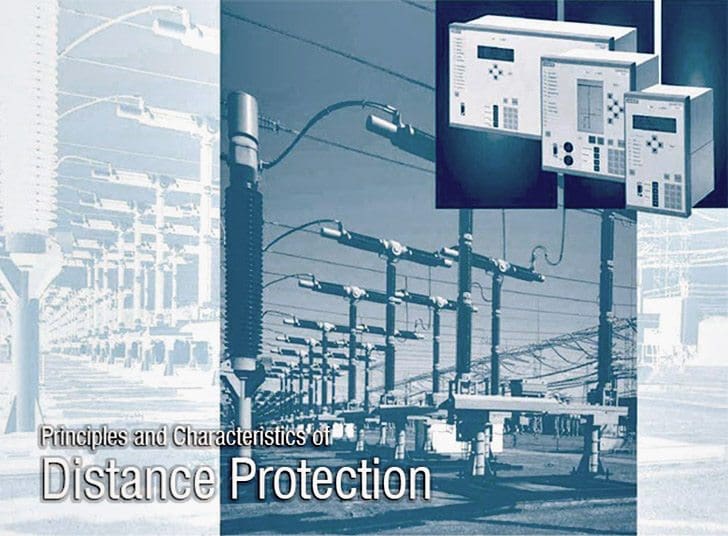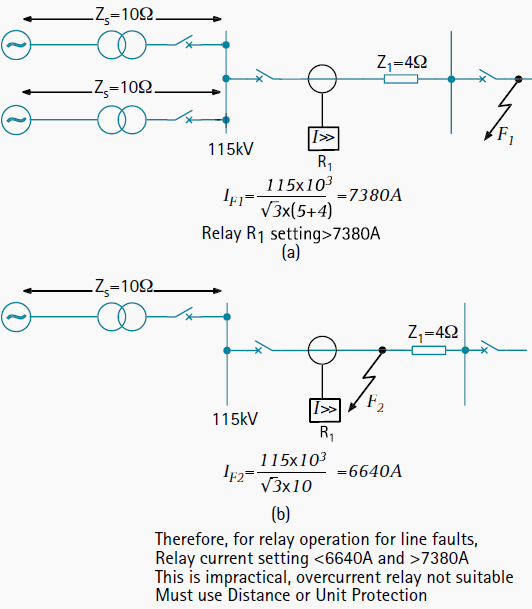Introduction to Distance Protection
Distance relays are one of the most important protection elements in a transmission line.

These relays may sometimes be set based in percentages of the line impedances, for example a typical setting for zone 1 is 80% of the impedance of the line in order to not reach the remote end, the zone 2 can be set at 120% of the impedance of the line in order to dependably overreach the line, Zone 3 sometimes are disabled or set to cover an adjacent line.
In the case of parallel lines, the mutual coupling of these lines can cause distance relays to under reach and over reach. For this reason the relay setting must consider this effect, some relays have algorithms to compensate, but it is necessary to use the current of the parallel line which adds complexity to the installation.
In some countries there criteria that a distance protection can not reach fault in other voltage levels, because fault clearing times in sub transmission levels may be slower than fault clearing times at the transmission level.
The problem of combining fast fault clearance with selective tripping of plant is a key aim for the protection of power systems.
To meet these requirements, high-speed protection systems for transmission and primary distribution circuits that are suitable for use with the automatic reclosure of circuit breakers are under continuous development and are very widely applied.
Unlike phase and neutral overcurrent protection, the key advantage of distance protection is that its fault coverage of the protected circuit is virtually independent of source impedance variations.

Distance protection is comparatively simple to apply and it can be fast in operation for faults located along most of a protected circuit. It can also provide both primary and remote back-up functions in a single scheme. It can easily be adapted to create a unit protection scheme when applied with a signalling channel.
In this form it is eminently suitable for application with high-speed auto- reclosing, for the protection of critical transmission lines.
Principles of Distance Relays
Since the impedance of a transmission line is proportional to its length, for distance measurement it is appropriate to use a relay capable of measuring the impedance of a line up to a predetermined point (the reach point).
The basic principle of distance protection involves the division of the voltage at the relaying point by the measured current. The apparent impedance so calculated is compared with the reach point impedance. If the measured impedance is less than the reach point impedance, it is assumed that a fault exists on the line between the relay and the reach point.
The reach point of a relay is the point along the line impedance locus that is intersected by the boundary characteristic of the relay.
Since this is dependent on the ratio of voltage and current and the phase angle between them, it may be plotted on an R/X diagram. The loci of power system impedances as seen by the relay during faults, power swings and load variations may be plotted on the same diagram and in this manner the performance of the relay in the presence of system faults and disturbances may be studied.
Relay performance
Distance relay performance is defined in terms of reach accuracy and operating time. Reach accuracy is a comparison of the actual ohmic reach of the relay under practical conditions with the relay setting value in ohms.
The impedance measuring techniques employed in particular relay designs also have an impact. Operating times can vary with fault current, with fault position relative to the relay setting, and with the point on the voltage wave at which the fault occurs.
Depending on the measuring techniques employed in a particular relay design, measuring signal transient errors, such as those produced by Capacitor Voltage Transformers or saturating CT’s, can also adversely delay relay operation for faults close to the reach point. It is usual for electromechanical and static distance relays to claim both maximum and minimum operating times.
However, for modern digital or numerical distance relays, the variation between these is small over a wide range of system operating conditions and fault positions.
Distance Relay Characteristics
Some numerical relays measure the absolute fault impedance and then determine whether operation is required according to impedance boundaries defined on the R/X diagram.
Traditional distance relays and numerical relays that emulate the impedance elements of traditional relays do not measure absolute impedance. They compare the measured fault voltage with a replica voltage derived from the fault current and the zone impedance setting to determine whether the fault is within zone or out-of-zone. Distance relay impedance comparators or algorithms which emulate traditional comparators are classified according to their polar characteristics, the number of signal inputs they have, and the method by which signal comparisons are made.
The common types compare either the relative amplitude or phase of two input quantities to obtain operating characteristics that are either straight lines or circles when plotted on an R/X diagram. At each stage of distance relay design evolution, the development of impedance operating characteristic shapes and sophistication has been governed by the technology available and the acceptable cost.
Since many traditional relays are still in service and since some numerical relays emulate the techniques of the traditional relays, a brief review of impedance comparators is justified.
Example of Modern Distance Protection Relay

This particulary relay has following ANSI protection functions:
| ANSI | Description | ANSI | Description |
| 21/21N | Distance protection | 50HS | Switch-onto-fault protection |
| FL | Fault locator | 50BF | Breaker failure protection |
| 50N/51N; 67N | Directional ground-fault protection | 59/27 | Overvoltage/undervoltage protection |
| 50/51/67 | Backup overcurrent protection | 81O/U | Over/underfrequency protection |
| 50 STUB | STUB-bus overcurrent stage | 25 | Synchro-check |
| 68/68T | Power swing detection/tripping | 79 | Auto-reclosure |
| 85/21 | Teleprotection for distance protection | 74TC | Trip circuit supervision |
| 27WI | Weak-infeed protection | 86 | Lockout (CLOSE command – interlocking) |
| 85/67N | Teleprotection for ground-fault protection |
Distance Protection Theory (VIDEO)
Resource: Network protection and automation guide – Areva; SIPROTEC47SA522 – Distance Protection Relay for Transmission Lines; An Example Distance Protection Application with Complicating Factors by Yofre Jacome and Charles F Henville











What does STUB stands for?
Nominal voltage is 154 kV, the distance of the overhead line is 60i the characteristic of the line is r=0.125 ohm/km ve x=0.270 ohm/km. A three-phase line is protected with a distance relay which is supplied from 150/5A CT and 154/0.1 kV VT. If the measured value is 0.25 ohm when a fault occurs, What is the distance of fault point from the head of the line?
Hello everyone, can someone help me out on how to solve this problem? thanks.
Even in case of the faults in protected line for that short section of 4%. For adjacent line it will be in reverse zone (Z4) & time delay for Z4 will be intentionaly high. so Z2 will surely clear that primary protected line.
In most of text books Zone 2 setting of distance relay and by author is recommended 120% of line impedance. Zone 1 is set at 80% expecting errors in CT/VT/Relay error/Impedance variations is 20%. If so with 120% line impedance setting fault coverage will be 96% to 144% and the over reaching zone 2 trips for fault in protected line close to remote substation < 4% line length or on bus at remote s/s. Right setting will be 130% protected line impedance for Zone2 coverage 104% to 156% line covering remote bus also which is a must as back up protection. S.Vasudevan 9840229620 Ex. Site Manager ABB/Sweden for Kuwait projects.
Very Helpful, thank you.
Hi!
Can you explain the economical and environmental effects or goals of distance protection? please
please send me updates
113, Chitnisnagar, Umrer road, Nagpur-440024.
Hi .. Can you explain the topic of Extensive Relay Protection using the microprocessor?I need this topic as fast as possible …. Thank you
what is the advantages and disadvantages of distance relay
What are the advantages of distance relays over overcurrent relays?
Sir I want to know in detail about STUB protection.
Very useful information. Sir plz tell how can we learn and read switch board drawings. And motor control center
respected sir,
is there any effect of ungrounded ct star point on distance shown by relay
Congratulations for a short presentation of the matter.
I suggest including some features I consider important for fully understanding of the distance protection aplications, such as:
– tied lines infeed for lines with ties;
– arc fault detection;
– week infeed;
– signaling for pilot applications;
– close-up faults;
– the use of the reverse zone for busbar fault protection
These are what I have in mind at the moment.
Thanks Emmanuel, I agree with you for adding.
very useful to me.
I’ةm very interest for above